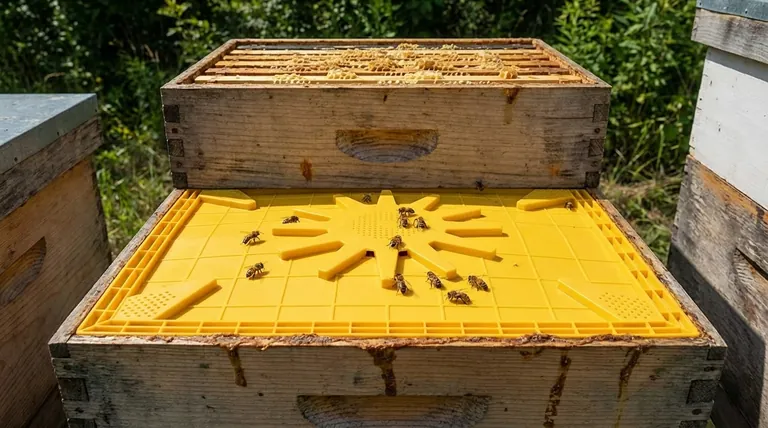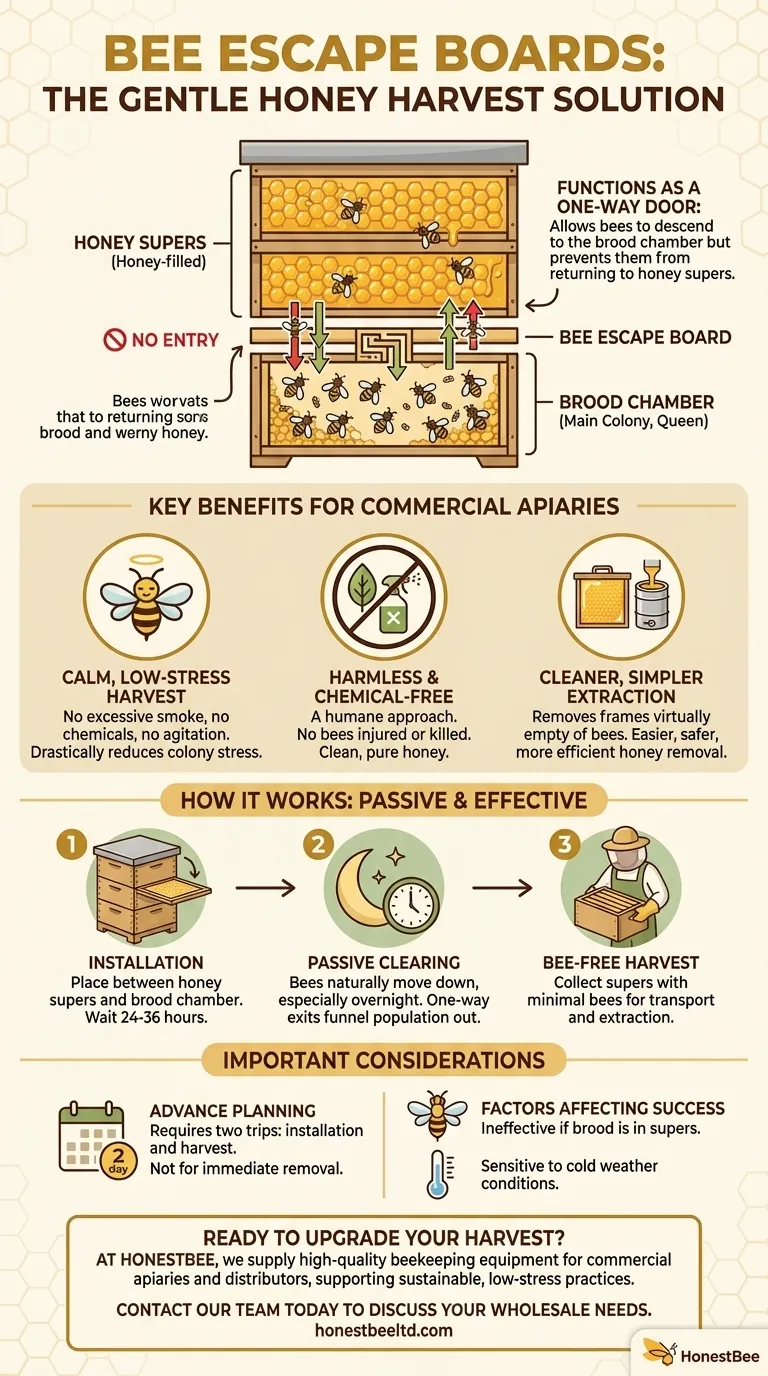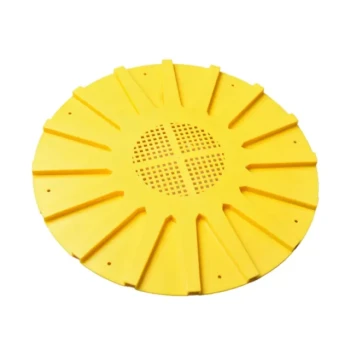At its core, a bee escape board is a specialized inner cover for a beehive that functions as a one-way door. It is placed between the honey-filled boxes (supers) you intend to harvest and the main brood chamber below. The board contains a small gate or maze that allows bees to travel down into the brood area but makes it extremely difficult for them to return, effectively and gently clearing the honey supers of bees over 24 to 36 hours.
The central purpose of a bee escape board is to replace disruptive harvesting techniques with a passive, low-stress method. It allows a beekeeper to remove honey frames that are almost entirely free of bees without using excessive smoke, chemicals, or aggressive brushing that can harm the colony.

How a Bee Escape Board Works
The effectiveness of a bee escape board lies in its simple yet ingenious design that leverages natural bee behavior. Understanding this mechanism is key to using it correctly.
The Principle of One-Way Travel
A bee escape board is fitted with a one-way exit. As bees naturally move throughout the hive and descend into the brood chamber, particularly overnight, they can easily pass through this exit.
When they attempt to return to the honey supers, they are unable to locate the small, complex entrance from the other side. This simple design passively funnels the hive's population out of the target boxes.
Proper Installation and Timing
The board must be placed correctly to function. It is installed directly beneath the honey supers you plan to harvest and above the lower boxes (brood chamber) where the queen resides.
This is not an instant solution. After installation, you must wait approximately 24 hours for the bees to vacate the supers. This requires planning your harvest at least a day in advance.
The Primary Benefits of This Method
Choosing a bee escape board over other clearing methods comes with significant advantages, primarily centered on the well-being of the colony.
A Calm, Low-Stress Harvest
The biggest benefit is the calm it brings to the harvesting process. By avoiding direct, forceful removal, the bees are not agitated or defensive. This drastically reduces the need for heavy smoking, which can stress the colony and potentially affect the taste of the honey.
A Harmless and Chemical-Free Approach
This method is widely considered one of the most humane ways to clear honey supers. Unlike brushing or using a bee blower, no bees are injured or killed in the process. It is also a completely chemical-free alternative to using a fume board with repellents.
Cleaner and Simpler Extraction
When you return to the hive after 24 hours, you can remove honey boxes that are virtually empty of bees. This makes the process of transporting frames and extracting the honey much cleaner and easier, as you are not contending with thousands of bees in your work area.
Understanding the Trade-offs and Considerations
While effective, the bee escape board is not a perfect solution for every situation. Its use comes with specific requirements and potential limitations.
The Need for Advance Planning
The primary drawback is the time required. The process necessitates two separate trips to the apiary: one to install the board and another a day later to collect the honey. This is less efficient than immediate methods like brushing or using a blower.
When It Might Not Work
The board's effectiveness can be compromised under certain conditions. If there is brood (unhatched bees) present in the honey supers, the nurse bees will not abandon it, rendering the board ineffective. This highlights the importance of using a queen excluder earlier in the season.
Additionally, any extra gaps or cracks in your hive equipment can create alternative entrances, allowing bees to bypass the board and re-enter the supers from the outside.
Weather Sensitivity
The process is dependent on normal bee movement. If the weather turns unexpectedly cold, the bees may cluster for warmth and will not move down through the escape board, halting the clearing process.
Making the Right Choice for Your Harvest
Selecting a harvesting method depends entirely on your goals, the scale of your operation, and your beekeeping philosophy.
- If your primary focus is bee welfare and a calm apiary: The bee escape board is the ideal choice, offering a gentle, non-invasive, and stress-free method.
- If your primary focus is speed for a large-scale operation: More direct methods like using a bee blower or a fume board may be more practical, despite being more disruptive to the bees.
- If you are a hobbyist with just one or two hives and no extra equipment: Manually brushing bees off each frame is a viable option, but you should be prepared for a more agitated colony.
Ultimately, the bee escape board empowers you to work in partnership with your colony, making it a cornerstone of gentle and sustainable beekeeping.
Summary Table:
| Key Feature | Benefit |
|---|---|
| One-Way Design | Gently funnels bees out of honey supers, preventing their return. |
| Passive Operation | Clears supers over 24-36 hours with no need for force or chemicals. |
| Low-Stress Harvest | Keeps the colony calm, reducing the need for heavy smoke. |
| Chemical-Free | A humane alternative to repellents; no bees are harmed. |
| Cleaner Extraction | Results in bee-free frames for easier, safer honey removal. |
Ready to upgrade your harvest with a gentle, effective bee escape board?
At HONESTBEE, we supply high-quality beekeeping supplies and equipment designed for the needs of commercial apiaries and beekeeping equipment distributors. Our wholesale-focused operations ensure you get reliable gear that supports sustainable, low-stress beekeeping practices.
Contact our team today to discuss your needs and discover how our equipment can benefit your operation.
Visual Guide

Related Products
- HONESTBEE Multi Exit Plastic Bee Escape Board for Efficient Honey Harvesting
- Efficient Hive Clearing: HONESTBEE 8-Way Plastic Bee Escape
- Professional Durable Two-Piece Plastic Bee Escape
- Circular Labyrinth Bee Escape for Efficient Hive Management
- High-Efficiency Diamond Maze Bee Escape for Clearing Supers
People Also Ask
- How long does it take for the Triangle Escape Board to empty the honey super of bees? A 24-48 Hour Guide
- How long should the Bee Escape Board be left on the honey supers? Achieve a Peaceful Harvest in 24 Hours
- What is an escape board used for? A Gentle, Chemical-Free Honey Harvest
- Where should the Bee Escape board be placed? For a Calm, Bee-Free Honey Harvest
- How long should you wait after placing a bee escape board before harvesting honey? Clear Your Supers in 24-48 Hours



















